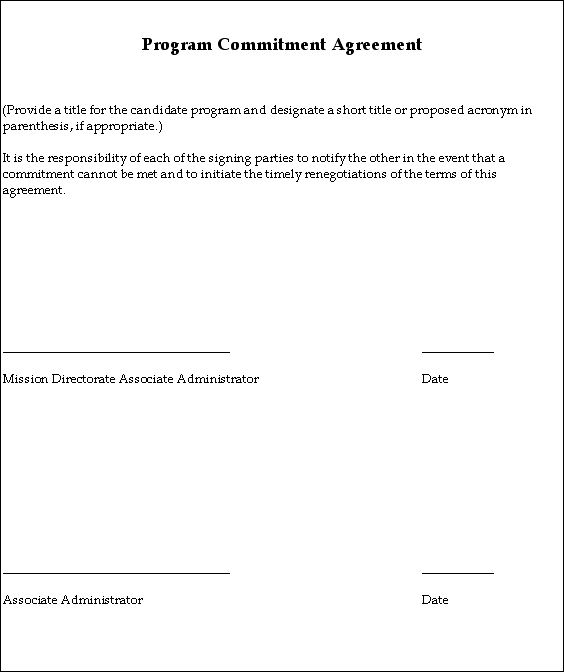APPENDIX D. Program Commitment Agreement Template
D.1 PCA Title Page

Figure D-1 Program Commitment Agreement Title Page
D.2 PCA Template
PROGRAM COMMITMENT AGREEMENT
(PROGRAM TITLE)
1.0
PROGRAM OBJECTIVES
Identify the broad program objectives. Describe the program’s
relationship to Mission Directorate goals, and objectives as
documented in the Directorate’s plan. Convey the public good
of the program to the taxpayer, stated in a way that can be
understood by the average citizen.
2.0
PROGRAM OVERVIEW
Describe the strategy to achieve the above-mentioned
objectives. Relationships with external
organizations, other agencies, or international partners should be
addressed if achievement of the program objectives is dependent on
their performance. Identify the associated projects to be
included in the program as of the writing date. Specify
the type of program (i.e., single-project, uncoupled, loosely
coupled, or tightly coupled) and the basis for that classification.
3.0
PROGRAM AUTHORITY
Describe the NASA organizational structure for managing the program
and projects from the MDAA to the NASA Center project
managers. Include lines of authority and reporting, Center(s)
responsibilities, the governing PMC(s) for the
oversight of the program and its known projects, and the
approving official for new projects. Identify any
delegated decision authority, per Section 2.4.
4.0
TECHNICAL PERFORMANCE COMMITMENT
Summarize the technical performance requirements, identifying
baselines and thresholds needed to achieve the program objectives,
as applicable. If the objectives include a technical
performance target (goal) in addition to a threshold
requirement, the commitment could be stated as a range. Demonstrate
traceability to Agency needs, goals, and objectives and Agency
requirements.
5.0
SCHEDULE COMMITMENT
Identify the following key target milestones for each project
in the program, such as:
1.
Start of
formulation.
2.
Target date
or timeframe for the SDR or MDR/PNAR.
3.
Target date or timeframe for the PDR/NAR or the start of
implementation.
4.
Start of operations.
5.
End of prime operations and/or disposal, if applicable.
6.
Other milestones or time periods as appropriate for a specific
program/project.
6.0 COST
COMMITMENT
Provide the estimated cost range for the program for the ten-year
period beginning in the current fiscal year at a level of detail
that identifies the approved individual projects. Identify
the constraints and assumptions used to develop this estimated cost
range and specifically identify those assumptions that drive the
range. This cost range should contain all costs
necessary to perform the program, including, but not limited to,
customary project activities, required technology developments,
facilities costs, launch vehicles, tracking, operations and
sustainment, data analysis, and disposal. Reference the
annual budget contained in the Integrated Budget and Performance
Document (IBPD) for cost phasing. The cost range should be updated
when program content changes, such as the addition of new projects
entering implementation.
7.0
ACQUISITION STRATEGY
Provide a brief statement of the proposed acquisition strategy
for major elements.
8.0
HIGH RISK AREAS
Identify the areas of highest risk for the program (covering
safety, technical, institutional, cost, or schedule issues) in
which failure may result in changes to the program/project baseline
cost, schedule, or technical performance requirements. This
section should identify, where possible, the specific risk drivers,
such as high-risk technologies upon which the program is dependent,
and mitigation options.
9.0
INTERNAL AGREEMENTS
If the program is dependent on other NASA activities outside of the
MDAA’s control to meet program objectives,
identify the required support and list any formal agreements
required.
10.0
EXTERNAL AGREEMENTS
Explain the involvement of external organizations, other agencies,
or international support necessary to meet the program
objectives. Include a brief overview of the program/project
relationships with such external organizations. Include an
identification of the commitments being made by the external
organizations, other agencies, or international partners and a
listing of the specific agreements to be concluded. Any
unique considerations affecting implementation of required
NASA policies and processes necessitated by the external
involvement should be clearly identified.
11.0
REVIEWS
Specify the type of reviews that will be performed during the life
cycle of the program/project.
12.0
OUTCOMES
Identify the discrete set of expected deliverables (outcomes) that
flow from the Agency goals and objectives, as defined in the Agency
Strategic Plan.
13.0
WAIVERS
Identify known waivers that will be sought for the program.
Provide rationale consistent with program characteristics such as
scope, complexity, visibility, cost, safety, and acceptable risk.
14.0
PCA ACTIVITIES LOG
Provide and maintain a log of all PCA activities, including
revisions that reflect all waivers to the original PCA. This
log includes the information shown in Figure D-2 and may be
supplemented with an attached addendum for each change, describing
the change. The PCA should be updated to add approved
projects or whenever substantial change makes it necessary.
|
|
|
|
|
Termination
|
MDAA
|
Associate Administrator
|
|
Date
|
Event
|
Change
|
Addendum
|
Review Req’d
|
Signature
|
Signature
|
|
dd/mm/yy
|
Revalidation
|
None
|
N/A
|
No
|
|
|
|
dd/mm/yy
|
Revalidation
|
None
|
N/A
|
No
|
|
|
|
dd/mm/yy
|
Approval of new project
|
Addition of Project N
|
Ref. #1
|
No
|
|
|
Figure D-2 Sample Program Commitment Agreement
Activities Log
DISTRIBUTION:
NODIS
This Document is Obsolete and Is No Longer Used.
Check the NODIS Library to access the current version:
http://nodis3.gsfc.nasa.gov
![[NASA Logo]](../Images/nasaball.gif)
